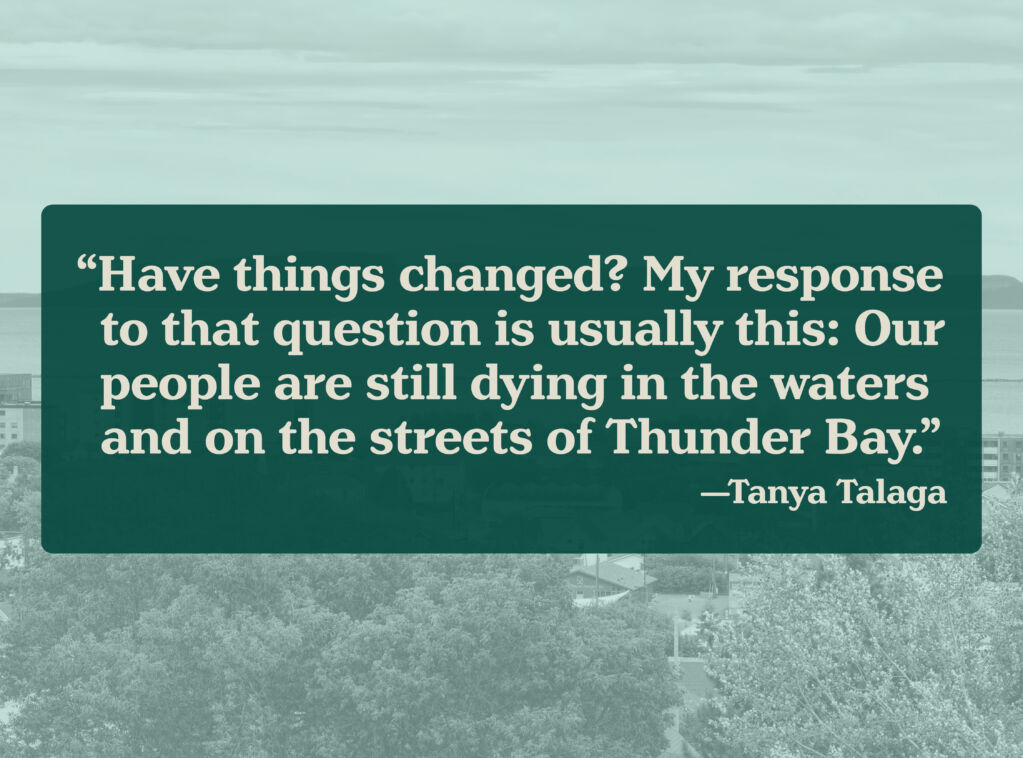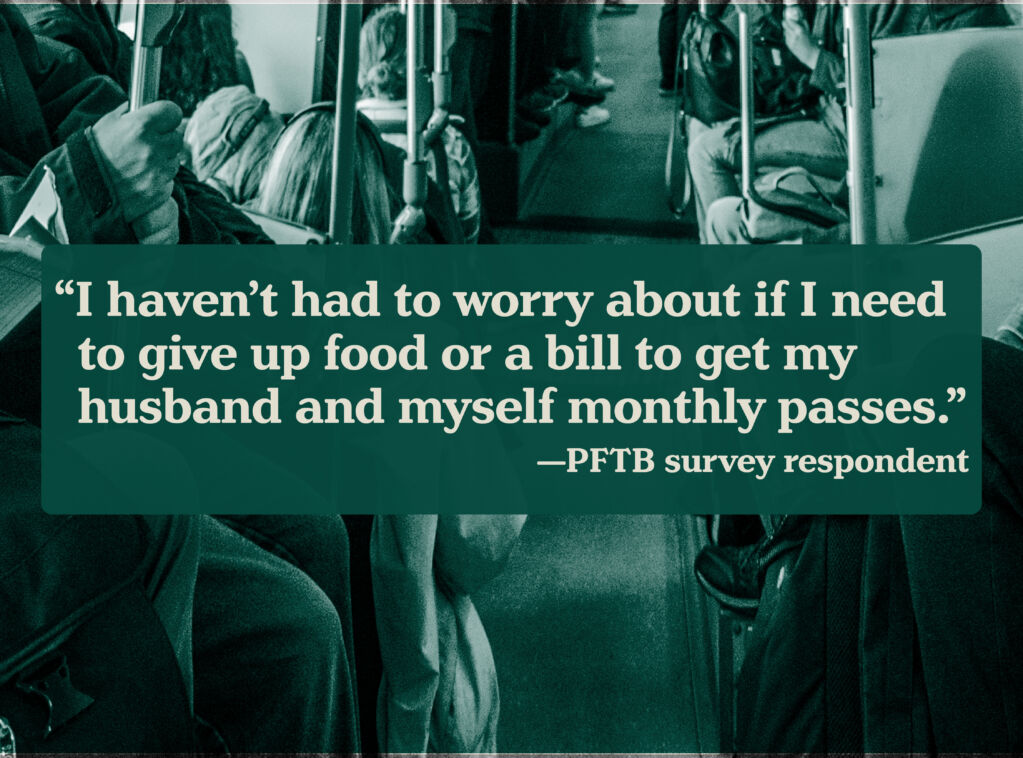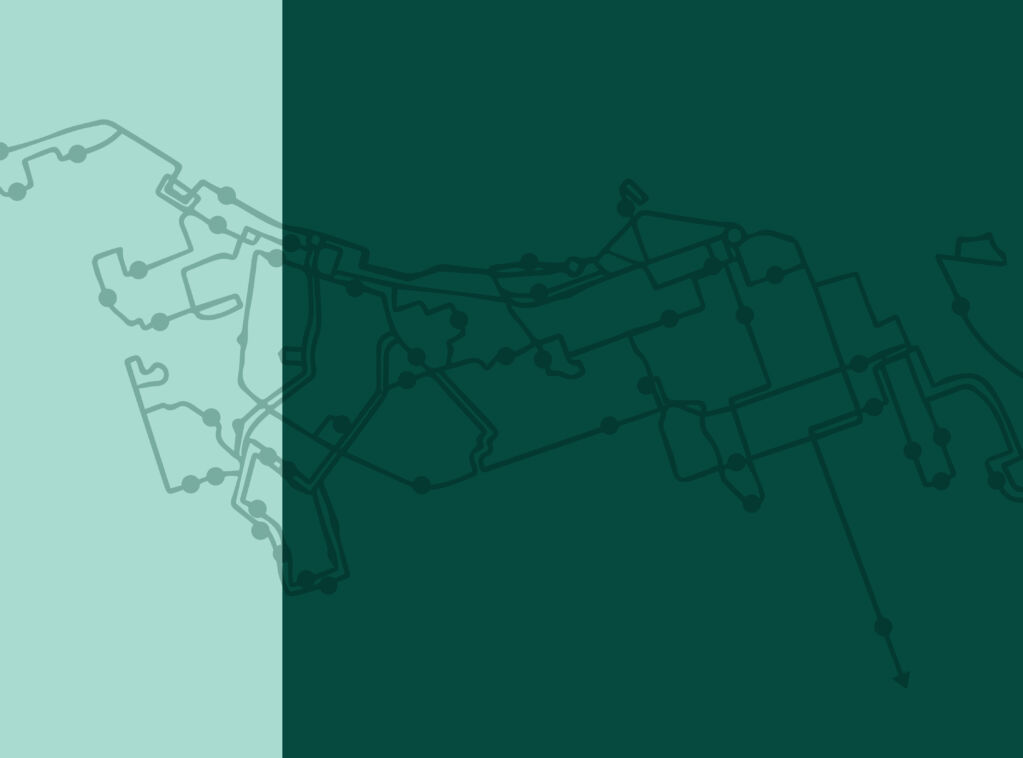On May 12, 2021, the federal government announced a new funding initiative aimed at a more equitable pandemic recovery.1 Explaining that “Public transit is at the heart of an inclusive recovery,” Infrastructure Canada announced their commissioning of a fleet of 60 new zero-emission streetcars, built in Thunder Bay, to be added to the Toronto Transit Commission’s system. This was framed as a win-win: transit for Toronto and jobs for Thunder Bay.2 However, when it came to investments in Thunder Bay’s transit system, the city didn’t receive similar funding to help them achieve net-zero greenhouse gas emissions by 2050.3
Understanding how this relates to First Nations, Inuit and Métis (FNIM) Peoples’ access to public transit across Canada is the first step to creating accessible transit systems that serve all communities across the country.
Barriers to accessing public transit can be broken into three broad categories: structural, organizational and systemic. Structural barriers include loss of service, high ticket prices and inadequate scheduling. Organizational barriers include how transit organizations and related institutions interact with FNIM riders and communities. These can include disproportionate carding and the creation of cumbersome bureaucratic processes that prevent FNIM riders from accessing supports. Finally, the larger, overarching systemic barriers relate to the embedded racism, white supremacy and neocolonialism that inform practices and justify underfunding services for FNIM communities.

Where We Are Now
In Focus: Thunder Bay
In 2015, 10.9% of Thunder Bay households had an after-tax income of less than $20,000 per year.4 The median household income for Thunder Bay in 2015 was $61,887, compared with the provincial median household income of $74,287.5 But there is another story within this economic picture, one of even greater disparity.
Fort William, one of 14 urban reserves in Ontario, is part of the Thunder Bay community and is included in the Census Metropolitan Area (CMA) by Statistics Canada. Urban reserves are First Nations land either within the boundaries of a municipality or adjacent to an urban area.6 When Fort William data is separated out from the rest of the community, it reveals stark economic inequality within Thunder Bay. In 2015, residents of the Fort William Census subdivision had a median household income of $41,728.7
Thunder Bay is also recognized as the urban centre with the eleventh largest FNIM population and the highest proportion of Indigenous people in the country—12.7%,8 a significant number of whom live outside of Fort William. A recent community-based study, developed by Well Living House, revealed that the Indigenous population in Thunder Bay is likely two to four times larger than census data suggests.9 The study also found significant health disparities between Indigenous adults in Thunder Bay and Ontario adults: 23% of Indigenous adults in Thunder Bay reported having unmet health needs in the 12 months preceding the study, compared with 10% of Ontario adults.10 When asked about the barriers to accessing care, a lack of transportation was one of the most common answers.
Thunder Bay also serves as an educational hub for many children from remote northern First Nations communities who travel hundreds of kilometres to Thunder Bay in order to attend grade 9. In late 2015, coroner David Eden launched an inquest into the deaths of seven First Nations youth who had made this journey.11 Known as the Seven Youth Inquest, it examined the deaths of 15-year-old Jethro Anderson (2000), 18-year-old Curran Strang (2005), 17-year-old Paul Panacheese (2006), 18-year-old Robyn Harper (2007), 15-year-old Reggie Bushie (2007), 17-year-old Kyle Morrisseau (2009) and 15-year-old Jordan Wabasse (2011).12 All seven children died while attending school in Thunder Bay, far from their families and First Nation communities.13 The inquest gathered testimonies from nearly 200 witnesses who detailed experiences of isolation, loneliness, racism and systemic failures that students arriving in Thunder Bay face.14 The Inquest’s primary purpose was to prevent future deaths of First Nations youth who leave their home communities to attend high school in Thunder Bay. Upon conclusion on June 28, 2016, the inquest’s Jury issued 145 recommendations including 31 directed to the City.15
Evaluating the Inquest's capacity to improve life for Indigenous Peoples five years after the recommendations were released, author Tanya Talaga reflected on Canada's continued indifference towards protecting Indigenous lives. “Have things changed? My response to that question is usually this: Our people are still dying in the waters and on the streets of Thunder Bay.”16
Public Transit in Thunder Bay
In a 2010 interview with Eric Andrew-Gee for the Globe and Mail, the city’s transit manager acknowledged that taking transit in Thunder Bay was not done by choice but out of need: “People in need here are disproportionately Indigenous, and the bus reflects that.”17 Still, riding the bus is not cheap for a community where many household incomes are below $40,000. An adult pass in Thunder Bay costs $930 annually, $660 for a senior or youth.18 Between the cost and the sparse service, only 3.9% of Thunder Bay residents rely on transit as their primary mode of transportation.19
Beyond municipal transit, Thunder Bay residents are further limited by intercity transit options. Via Rail shuttered their service to Thunder Bay in 1990.20 Greyhound Canada ended their services in 2018, leaving Ontario Northland as the sole service provider for the region. While Ontario Northland does provide frequent transit options out of Thunder Bay—which is more than other cities can say after the departure of Greyhound—the ticket to ride is prohibitively expensive. A one way ticket from Thunder Bay to Sudbury is more than $150; to Toronto it’s more than $200.21
Leading up to and throughout the pandemic, Thunder Bay’s city council has been exploring a reduced service model for the city’s bus system. This new on-demand service has already been introduced for one route22 and is being considered for others including the #6 Mission route which services the Fort William First Nation. Already, the Nation’s bus service is limited to weekdays between 7:30 am and 6:30 pm.23 As the CCPA Ontario’s recently released study, Disproportionate Burden, emphasized, Indigenous women’s employment is heavily concentrated in the health care and social services; accommodation and food services; and retail trade industries. Indigenous men’s employment is concentrated in construction; manufacturing; and transportation and warehousing industries.24 These industries require workers to accommodate flexible schedules. As such, a bus service whose last run leaves for Fort William at 5:55 pm does not provide adequate coverage to ensure that workers can get to and from work.
Changes to the system extend beyond service. Andrew-Gee noted in his feature on the system that, in 2010, the City opted to tear down the bus terminal, where Indigenous youth would congregate.25 The building was replaced with a series of outdoor shelters where waiting riders are exposed to the elements—an inhospitable choice in a city where the average temperature in January is -20.

During the pandemic, Thunder Bay took an important—albeit temporary—step to improve access to transit. Between March 21 and July 20, 2020, Thunder Bay Transit waived bus fares for all riders.26 Following the fare-free phase, Poverty Free Thunder Bay (PFTB) conducted a survey of transit users to see how the program had impacted them.
Responses from participants spoke to the impact that the program had on improving the quality of life for low-income residents. “I haven’t had to worry about if I need to give up food or a bill to get my husband and myself monthly passes," reported one PFTB survey respondent.
Based on the responses, PFTB recommended a gradual fare decrease starting in 2021 that would lead to the phasing out of fares by January 1, 2023. This recommendation was supported by the Thunder Bay Indigenous Friendship Centre, Thunder Bay and District Injured Workers Support Group, the Kinna-Aweya Legal Clinic, the Ontario Native Women’s Association, the Humanities 101 Program at Lakehead University and many more organizations throughout the region.27
Where Can We Go From Here?
The possibility of free transit has the potential to address recommendations from several key reports.
Seven Youth Inquest:
Recommendation 70. To Canada: “In order to provide all First Nations students living in Thunder Bay with reasonable travel time and safe transportation to school and access to all extracurricular activities, in consultation with [partners] conduct an assessment of funding required to ensure that [students] have access to reasonable transportation while attending school or extracurricular activities.”28
While this recommendation proposed a fleet of school buses, providing access to fare-free public buses would ensure broader service for First Nations students to access safe transit before, during and after school hours.
Recommendation 102. To The City of Thunder Bay: “The City of Thunder Bay should consult and liaise with [partners] in order to develop a plan for assisting those students who would like to attend City programs or have questions with respect to any City programs but may have some issue to overcome such as transportation issues to and from the venue.”29
Again, this could be addressed by providing fare-free service.
The connection between transportation and wellbeing is not limited to Indigenous youth. When interviewing participants, the National Inquiry into Missing and Murdered Indigenous Women and Girls heard about barriers to transit for Indigenous women, girls and 2SLGBTQQIA+ people as barriers to leaving abuse, and finding safety and community.30 “A lack of safe and affordable transportation can mean that people may be forced to rely on other transportation methods, such as walking or hitchhiking, not only to escape dangerous situations but simply to travel for education or employment.”31
When it comes to addressing public transportation gaps and improving service, interjurisdictional cooperation is vital to achieving these aims. As Andrew-Gee’s reporting acknowledged, addressing the shortfalls of Thunder Bay’s public transportation system exceeds the reach of the city’s municipal budget.32 That is why Poverty Free Thunder Bay encouraged the City to lobby the federal government for funding to create a net-zero emissions-capable system that offers fare-free service.33
In their final report, the National Inquiry into Missing and Murdered Indigenous Women and Girls emphasized, “The need for greater interjurisdictional cooperation is a crucial recommendation in existing reports concerning violence against Indigenous women and girls. In these reports, important areas highlighted for cooperation include… better public transportation services.” 34
The United Nations Declaration on the Rights of Indigenous Peoples (UNDRIP):
Article 21.2: “States shall take effective measures and, where appropriate, special measures to ensure continuing improvement of their economic and social conditions. Particular attention shall be paid to the rights and special needs of Indigenous elders, women, youth, children and persons with disabilities.”35
The importance of reliable public transportation has been identified by myriad inquests and research initiatives including the Seven Youth Inquest; the National Inquiry into Missing and Murdered Indigenous Women and Girls; and Our Health Counts Thunder Bay. The UNDRIP Article 21.2 is included in the City of Thunder Bay’s Indigenous Relations and Inclusion Strategy: 2021-2027, above their “Declaration of Commitment – Strengthening Relationships between the City of Thunder Bay and Urban [Indigenous] People: Work with [Indigenous] Peoples to identify and assist with the removal of barriers that hinder their full participation in community life.36
UNDRIP Article 22: "Particular attention shall be paid to the rights and special needs of Indigenous elders, women, youth, children and persons with disabilities in the implementation of this Declaration.
States shall take measures, in conjunction with Indigenous Peoples, to ensure that Indigenous women and children enjoy the full protection and guarantees against all forms of violence and discrimination."37
Statistics show that women are more likely to rely on public transit for transportation. As the National Inquiry identified, reliable transportation is a critical factor for ensuring the safety of Indigenous women, girls and 2SLGBTQQIA+ people in Canada.
Truth and Reconciliation Call to Action
89. "We call upon the federal government to amend the Physical Activity and Sport Act to support reconciliation by ensuring that policies to promote physical activity as a fundamental element of health and well-being, reduce barriers to sports participation, increase the pursuit of excellence in sport, and build capacity in the Canadian sport system, are inclusive of [Indigenous] peoples."
The Seven Youth Inquest recognized that lack of reliable transportation was a barrier to sports participation.
92. ii. "Ensure that [Indigenous] Peoples have equitable access to jobs, training, and education opportunities in the corporate sector, and that [Indigenous] communities gain long-term sustainable benefits from economic development projects."
Transit fares and limited service present barriers to both employment and education opportunities for Indigenous people. The limited fare-free program in Thunder Bay helped all of the city’s low-income residents travel more easily for a period in 2020. Given that Thunder Bay’s FNIM community is disproportionately low income, access to continued fare-free transit would improve their ability to get to work and school.
There is further opportunity still, in expanding public transit in Thunder Bay. As the Northern Policy Institute38 identifies, urban reserves have the potential for economic development that strengthens relationships between Indigenous and non-Indigenous residents of the community while also providing economic opportunities for the First Nation. However, as it stands, Fort William is underserved by public transit and the
City is currently considering a further reduction of that service.
The issues described in this article are not unique to Thunder Bay. Currently, communities across Canada are struggling with pandemic-fuelled cuts to municipal service and a patchwork of transportation systems in the aftermath of Greyhound Canada’s shuttering.39 An independent review of the Toronto Transit Commission’s enforcement patterns in 2021 revealed that Indigenous passengers were 3.1 times more likely to be stopped by TTC fare inspectors than white passengers.40 In British Columbia, the provincial government has funded new transit lines along Highway 16, also known as the Highway of Tears. While the Highway of Tears Symposium recommended adding public transportation to the highway to improve safety for Indigenous women traveling in the corridor,41 the Symposium also recommended that the transit be provided free of charge to remove barriers to access.42 Contrary to this second suggestion, the routes range in cost with the most notable being $40 one way for passengers travelling from Prince George to Takla Landing43—a First Nation where the median income in 2015
was $17,100.44
Thunder Bay is used to demonstrate these challenges in real time, but the structural, organizational and systemic barriers that filter into and affect the accessibility of public transit need to be considered for each CMA and the communities they serve across Canada.
Notes
Illustrations and layout of the print version done by Katie Sheedy
1 Infrastructure Canada (2021, May 12). Supporting public transit and protecting jobs in Thunder Bay. https://www.canada.ca/en/offic...
2 Ibid.
3 Poverty Free Thunder Bay. (2020, October 19). Fare-Free is Fair: Poverty Free Thunder Bay Fare-Free Public Transit Survey. Contained within the Additional information for December 7 20202 Committee of the Whole meeting, accessed at https://www.thunderbay.ca/en/c...
4 Wellesley Institute. (2019). Community Report Thunder Bay: Supports for Success. https://www.wellesleyinstitute...
5 Statistics Canada. (2021, October 27).Census Profile, 2016 Census: Thunder Bay [Census metropolitan area], Ontario and Ontario [Province]. https://www12.statcan.gc.ca/ce...
6 Northern Policy Institute (2021, January 18). The Untapped Potential of Urban Reserves in Northern Ontario. https://www.northernpolicy.ca/untapped-potential
7 Statistics Canada. (2021, October 27). Census Profile, 2016 Census Thunder Bay [Population centre], Ontario and Fort William 52, Indian reserve [Census subdivision], Ontario. https://www12.statcan.gc.ca/ce...
8 Rinne, G. (2017, October 25). Thunder Bay has highest proportion of Aboriginal people in Canada. TBnewswatch.com https://www.tbnewswatch.com/lo...
9 Turner, L. (2021, November 22). Indigenous population in Thunder Bay two to four times larger than census data, new study says. CBC News. https://www.cbc.ca/news/canada...
10 Well Living House. (2021). Our Health Counts Thunder Bay. http://www.welllivinghouse.com...
11 Apollonio, M. (2016, April 4). Out there: First Nations kids are travelling hundreds of kilometres to attend high school. CBC Radio. https://www.cbc.ca/radio/docpr...
12 For more information on the Seven Youth Inquest, please read Seven Fallen Feathers by Tanya Talaga, https://houseofanansi.com/prod...
13 Talaga, T. (2021, September 6). Canada's indifference to the deaths of seven First Nations teenagers is 'just plain racism': Tanya Talaga. CBC: The Passionate Eye. https://www.cbc.ca/documentari...
14 Apollonio, M. (2016, April 4). Out there: First Nations kids are travelling hundreds of kilometres to attend high school. CBC Radio.
15 City of Thunder Bay. (n.d.). Response to Seven Youth Inquest. https://www.thunderbay.ca/en/c...;
16 Talaga, T. (2021, September 6). Canada's indifference to the deaths of seven First Nations teenagers is 'just plain racism': Tanya Talaga. CBC: The Passionate Eye. https://www.cbc.ca/documentari...
17 Andrew-Gee, E. (2019, October 7) Thunder Bay’s diverging paths: What bus routes and pickup trucks have to do with race and class. https://www.theglobeandmail.co...
18 City of Thunder Bay. (n.d.) Fares and Passes. https://www.thunderbay.ca/en/c...
19 Statistics Canada (2020, June 2). Proximity to Public Transportation in Canada's Metropolitan Cities, and related Commuting Data. https://www150.statcan.gc.ca/t...
20 Andrew-Gee, E. (2019, October 7) Thunder Bay’s diverging paths: What bus routes and pickup trucks have to do with race and class. https://www.theglobeandmail.co...
21 https://tickets.ontarionorthla...
22 Kaufman, I. (2021, October 28). Neebing councillor unhappy with on-demand transit plans. TBnewswatch.com. https://www.tbnewswatch.com/lo...
23 City of Thunder Bay. (2021, August 10). 6 Mission Road Schedule. https://www.thunderbay.ca/en/c...
24 Alook, A., Block,S. and Galabuz, G. (2021). iA Disproportionate Burden. Canadian Centre for Policy Alternatives. https://www.policyalternatives...
25 Andrew-Gee, E. (2019, October 7) Thunder Bay’s diverging paths: What bus routes and pickup trucks have to do with race and class. https://www.theglobeandmail.co...
26 Poverty Free Thunder Bay. (2020, October 19). Fare-Free is Fair: Poverty Free Thunder Bay Fare-Free Public Transit Survey. Contained within the Additional information for December 7 20202 Committee of the Whole meeting, accessed at https://www.thunderbay.ca/en/c...
27 See https://www.thunderbay.ca/en/c...
28 Office of the Chief Coroner Ontario. (2016). Verdict of Coroner’s Jury. Page 24. https://ocaarchives.files.word...
29 Office of the Chief Coroner Ontario. (2016). Verdict of Coroner’s Jury. Page 36. https://ocaarchives.files.wordpress.com/2019/01/jury-verdict-and-recommendations.pdf
30 National Inquiry into Missing and Murdered Indigenous Women and Girls (Reclaiming Power and Place: The Final Report of the National Inquiry into Missing and Murdered Indigenous Women and Girls, Volume 1a, page 449.
31 National Inquiry into Missing and Murdered Indigenous Women and Girls (Reclaiming Power and Place: The Final Report of the National Inquiry into Missing and Murdered Indigenous Women and Girls, Volume 1a, page 552.
32 Andrew-Gee, E. (2019, October 7) Thunder Bay’s diverging paths: What bus routes and pickup trucks have to do with race and class. https://www.theglobeandmail.co...
33 Poverty Free Thunder Bay. (2020, October 19). Fare-Free is Fair: Poverty Free Thunder Bay Fare-Free Public Transit Survey. Contained within the Additional information for December 7 20202 Committee of the Whole meeting, accessed at https://www.thunderbay.ca/en/c...
34 National Inquiry into Missing and Murdered Indigenous Women and Girls (Reclaiming Power and Place: The Final Report of the National Inquiry into Missing and Murdered Indigenous Women and Girls, Volume 1a, page 561.
35 United Nations. (2007). United Nations Declaration on The Rights of Indigenous Peoples. Page 17. https://www.un.org/development/desa/indigenouspeoples/wp-content/uploads/sites/19/2018/11/UNDRIP_E_web.pdf.
36 City of Thunder Bay. (2021). Indigenous Relations and Inclusion Strategy. Page 14. https://www.thunderbay.ca/en/city-hall/resources/Images/Aboriginal-Relations/IRI-Strategy/_COTB_IndigenousStrategy.pdf
37 United Nations. (2007). United Nations Declaration on The Rights of Indigenous Peoples. Page 17. https://www.un.org/development/desa/indigenouspeoples/wp-content/uploads/sites/19/2018/11/UNDRIP_E_web.pdf.
38 Northern Policy Institute (2021, January 18). The Untapped Potential of Urban Reserves in Northern Ontario. https://www.northernpolicy.ca/untapped-potential
39 Assemble of Manitoba Chiefs (2018, October 31). First Nations citizens across Manitoba need access to reliable public transportation services. https://manitobachiefs.com/first-nations-citizens-across-manitoba-need-access-to-reliable-public-transportation-services/, Noakes, S. (2018, October 31). Greyhound service in Western Canada stops at midnight: Now what? CBC News. https://www.cbc.ca/news/business/greyhound-western-canada-1.4884374, Kurjata, A. (2018, February 21) Greyhound to stop serving B.C.'s Highway of Tears, Yukon and Vancouver Island. https://www.cbc.ca/news/canada...
40 Spurr, B. (2021, April 8). Black and Indigenous riders are ‘grossly overrepresented’ in TTC transit enforcement data, report finds. https://www.thestar.com/news/g...
41 Lheidli T’enneh First Nation, Carrier Sekani Family Services, Carrier Sekani Tribal Council, Prince George Native Friendship Centre & Prince George Nechako Aboriginal Employment & Training Association. (2006, June 16). Highway of Tears Symposium Recommendations Report, page 19. https://www.highwayoftears.org...
42 Lheidli T’enneh First Nation, Carrier Sekani Family Services, Carrier Sekani Tribal Council, Prince George Native Friendship Centre & Prince George Nechako Aboriginal Employment & Training Association. (2006, June 16). Highway of Tears Symposium Recommendations Report, page 20. https://www.highwayoftears.org...
43 British Columbia Ministry of Transportation and Infrastructure. (2020, March). Highway 16 Transportation Options. https://www2.gov.bc.ca/assets/...
44 Statistics Canada (2021, April 20). A snapshot: Status First Nations people in Canada. https://www150.statcan.gc.ca/n...







